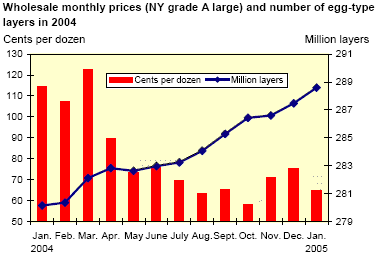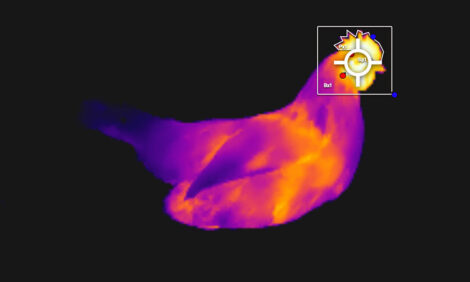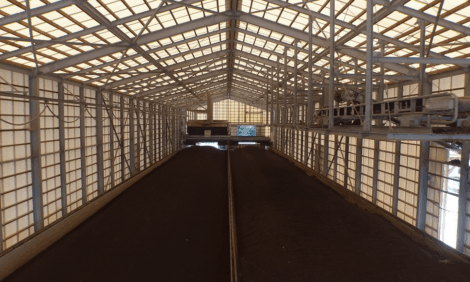



US Poultry Outlook Report - March 2005
By U.S.D.A., Economic Research Service - This article is an extract from the March 2005: Livestock, Dairy and Poultry Outlook Report, highlighting Global Poultry Industry data. The report indicates that the overall broiler production estimate for 2005 is 35.13 billion pounds, up 3.1 percent from 2004.
Poultry:
Even with the higher broiler production forecast, broiler prices
are expected to gradually strengthen in 2005, but remain below their year-earlier
levels during the first half of 2005.
Turkey production in 2005 is forecast at 5.58 billion pounds, up 2.2 percent from
the production seen in 2004, but lower than in 2003. With lower stock levels and
only a small increase in production forecast, prices for whole birds are expected to
remain above their year-earlier levels during the first half of 2005.
Turkey exports for 2005 are forecast at 510 million pounds, based on continued
growth in sales to Mexico and Canada along with strong improvement in shipments
to a number of Asian countries. A rapid resolution of current export problems to
the Mexican market will be the key to overall export levels as shipments to Mexico
accounted for 61 percent of all exports in 2004.
Eggs:
In 2005, table egg production is expected to increase to about 6,465 million dozen, nearly 1.6 percent over 2004, while prices are expected to move downward to between 64-68 cents per dozen at the wholesale level and about 20 percent below 2004’s $1.30 per dozen retail price. Egg exports in 2005 are expected to be about 20 percent higher than in 2004, due mainly to declining U.S. prices.
Broiler Production Down in January but Expected Higher for all of 2005
Broiler production for January 2005 was estimated at 2.81 billion pounds, down less
than 1 percent from the previous year. Weekly chick placements over the last 5
weeks have been averaging about 3.5 percent higher than last year, and the forecast
for broiler production in the first quarter of 2005 is 8.45 billion pounds, 3.1 percent
higher than at the same time in 2004. Along with the increase in the number of
chicks being placed for growout, the average weight of birds at slaughter has been
about 1 percent higher than a year ago. Broiler producers are expected to increase
production in 2005 due to a combination of a relatively strong domestic economic
growth, lower average prices for both corn and soybean meal, and higher export
demand fueled by a weaker dollar. The overall broiler production estimate for 2005
is 35.13 billion pounds, up 3.1 percent from 2004.
Revisions in the 2004 broiler production estimates produced changes in the
quarterly estimates, but left the annual total unchanged. Total broiler production
was 34.06 billion pounds, up 4.0 percent from 2003. The higher production in 2004
was due to a 1.0-percent increase in the average slaughter weight and a 2.5-percent
increase in the total number of broilers slaughtered.
Over the first 2 months of 2005, the 12-city whole broiler price averaged 71.4 cents
a pound, down less than 1 percent from the same period in 2004. Prices for most
broiler products have strengthened compared with fourth-quarter 2004, but are
below where they were during the first 2 months of 2004. Boneless-skinless breast
meat prices in the Northeast market averaged $1.47 per pound during January and
February 2005, down 13 percent from a year earlier. Prices for rib-on breasts
averaged 88.2 cents per pound, a decline of 8 percent from the same time in 2004.
Broiler prices have risen over the last couple of months partly because strong export
demand has reduced cold storage holdings. Leg quarter prices during the first 2
months of 2005 averaged 30.1 cents per pound, down 13 percent from the same
period in 2004, but up slightly from the fourth quarter of 2004. Even with higher
broiler production forecast, broiler prices are expected to gradually strengthen in
2005, although they are expected to remain below their year-earlier levels during
the first three-quarters of the year.
Broiler exports in 2004 totaled 4.77 billion pounds, down 3.1 percent from 2003.
Exports last year accounted for 14 percent of domestic production. Most of the
decline in broiler exports came from large decreases in shipments to Asian countries
such as Hong Kong/China (down 56 percent), Japan (down 33 percent) and Korea
(down 54 percent). These declines were partially offset by strong increases in
exports to Mexico, Turkey, and some CIS countries, specifically Ukraine and
Azerbaijan.
Although shipments to Russia were below year-earlier levels for most
of 2004, strong shipments over the last 3 to 4 months of the year brought total
exports to 1.5 billion pounds. This export total is 3.1 percent higher than in 2003
but below the 1.52 billion pounds exported in 2002. Broiler exports to Russia last
year accounted for 32 percent of total exports and represented 42 percent of all U.S.
leg quarter shipments. Although the quantity of broiler shipments was down
slightly in 2004, strong prices, especially during the first half, pushed the value of
exports to $1.73 billion, up 16 percent from 2003. With lower prices forecast for
the first half of 2005 and a weaker dollar relative to a number of currencies, broiler
exports are expected to reach just over the 5 billion pounds, the second highest
yearly total.
Turkey Production Forecast Up in 2005
Turkey production in 2005 is forecast at 5.58 billion pounds, up 2.2 percent from
the production seen in 2004, but lower than in 2003. The revised production total
for 2004 is 5.45 billion pounds, up slightly from the last estimate. During 2004,
placements of poults for growout were almost always below the previous year, and
the number of birds slaughtered in 2004 was down 5 percent from the previous
year. The reduced slaughter was partially offset by a 1.2-percent increase in the
average liveweight of turkeys being slaughtered. The higher prices for most turkey
products in 2004 and the forecast for lower feed costs are expected to boost turkey
production in 2005, after falling in the last 2 years.
With lower production in 2003 and 2004, cold storage holdings of both whole birds
and turkey parts have fallen. Turkey stocks at the end of 2004 were down 19
percent from the previous year. Lower turkey stocks are expected to continue
during the first half of 2005. With lower stock levels and only a small increase in
production forecast, prices for whole birds are expected to remain above their yearearlier
levels during the first half of 2005.
Turkey Export Quantity Down, but Value Higher
Turkey exports in 2004 followed much the same pattern as broiler exports. At 443
million pounds, turkey exports were 8.4 percent smaller than in 2003. Again much
of the decline came from smaller shipments to Asian countries. In 2004, turkey
exports to Hong Kong/China, Korea, and Japan all declined by over 40 percent, as
shipments were impacted by bans due to Avian Influenza outbreaks. These
reductions were partially offset by higher shipments to Mexico, Canada, and Russia.
While the quantity of turkey exports was down 8.4 percent in 2004, strengthening
prices pushed the value of these exports to $300 million, 12.6 percent higher than in
the previous year.
Since Mexico accounts for such a large percentage of all turkey exports, any change
in the export status of turkey products can have a large impact on the U.S. turkey
market. In the middle of February, Mexico placed a partial ban on turkey products
due to an outbreak of low pathogenic Avian Influenza in a breeder flock in North
Carolina. North Carolina is one of the largest turkey producers. The ban was
narrowed to allow products that were going to be further processed to enter the
country.
Turkey exports for 2005 are forecast at 510 million pounds, based on continued
growth in sales to Mexico and Canada, along with strong improvements in exports
to a number of Asian countries. A rapid resolution of export restrictions to the
Mexican market will be the key to overall export levels in 2005. Shipments to
Mexico accounted for 61 percent of all turkey exports in 2004.
Eggs - Buildup of Layer Flocks Push Prices Down From High Records Early in 2004
Fluctuations in laying flocks over the last 2 years caused wide variation in
wholesale table egg prices. After prices for wholesale table eggs (NY grade A
large) bottomed-out in May 2003 at 67.67 cents per dozen, declining egg supplies
from smaller layer flocks caused prices to climb for the rest of 2003. Prices
achieved the highest level ever in November 2003 at 122.94 cents per dozen, and
fell afterwards to 57.85 cents per dozen in October. For all of 2004, prices averaged
82.18 cents per dozen, 6.5 percent below the average wholesale price for 2003.
Retail egg prices last year peaked in March at $1.625 per dozen, falling thereafter to
the year’s low of 88.6 cents per dozen in November. For 2004, retail egg prices
averaged $1.305 per dozen, the highest ever recorded.
High producer returns in late 2003 drove repopulation of laying flocks. The rapid
rise of the U.S. layer flocks in 2003-04 has set the stage for the lower egg prices
that are expected in 2005. From January 2004 to January 2005, U.S. egg-type
layers rose by 8.5 million birds, from 280.1 to 288.6 million egg-type layers. The
rapid buildup of the laying flocks brought the U.S. egg-type layers to the largest
historical inventory ever. Consequently, table egg production in 2004 was also at a
record-high of 6,365 million dozen, 2.2 percent over 2003. In 2005, table egg
production is expected to increase to about 6,465 million dozen, nearly 1.6 percent
over 2004, while prices are expected to move downward to between 64-68 cents per
dozen at the wholesale level and about 20 percent below last year’s $1.305 per
dozen retail price.

2005 Exports Expected Tto Increase 20 Percent Over Last Year
In 2004, U.S. exports of eggs and egg products (in shell egg equivalents) have substantially recovered from as low as 23.2 million dozen in the first quarter to 53.2 million dozen in the fourth quarter. Bans on all poultry and product exports due to outbreaks in early 2004 of Avian Influenza were confined to a few States and then completely lifted. As normal trade resumed, U.S. exports of eggs and egg products rose substantially. For example, U.S. exports of eggs and egg products (in shell egg equivalents) to the North American Free Trade Agreement more than tripled from 9.08 to 27.52 million dozen between the first and the fourth quarter of 2004. Likewise, U.S. exports to East Asia (Japan, Hong Kong, S. Korea, China, and Taiwan) rose from 4.9 to 11.3 million dozen and to the EU-15 from 2.4 to 4.9 million dozens during the same period. The U.S. export market for shell eggs and egg products looks more promising in the future, due to competitive U.S. prices, high quality, and restrictive production measures imposed on layer flocks in the European Union. Egg exports in 2005 are expected to be about 20 percent higher than in 2004.
Links
For more information view the full Livestock, Dairy and Poultry Outlook - March 2005 (pdf)Source: Livestock, Dairy and Poultry Outlook - U.S. Department of Agriculture, Economic Research Service - March 2005








